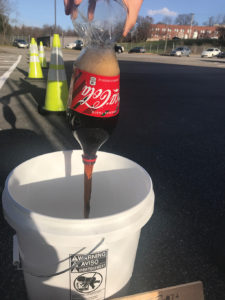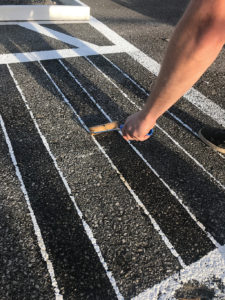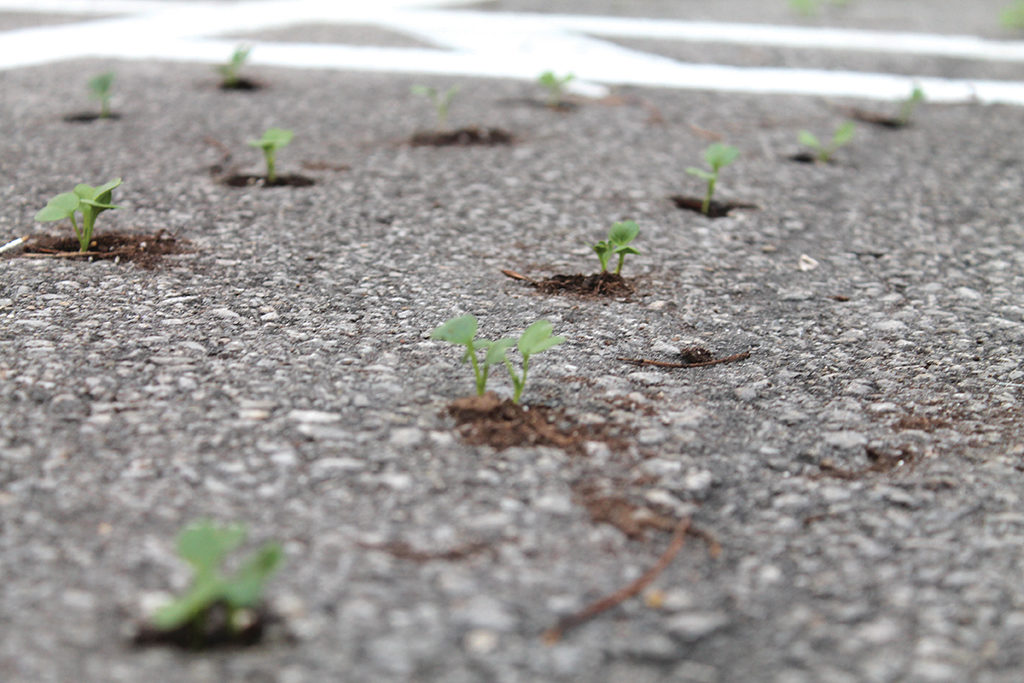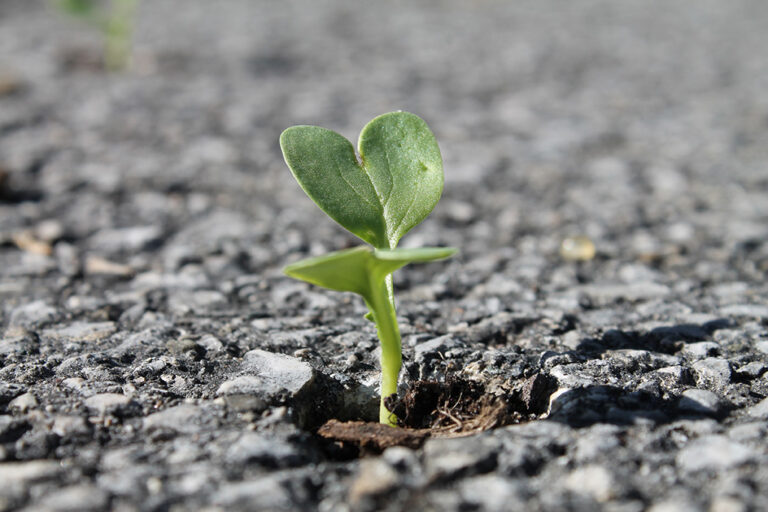On the right day, in a fenced-off corner of the student parking lot, one may find a curious scene: an art student applying Coca- Cola to the pavement with a paint roller. Behind her, radishes grow from holes drilled into the asphalt, and nearby, two Berea College professors patiently monitor the progress of an art installation/science experiment that in two years will answer some important questions about paved surfaces.
Daniel Feinberg, assistant professor of design and sculpture, keeps at the ready an astonishing list of facts about asphalt. He’ll tell you that the amount of impervious surface in the United States is about the same size of Ohio, that the number of parking spaces alone is the size of West Virginia, that Des Moines, Iowa, provides 20 parking spaces per household, and that 97-percent-impervious Jakarta, Indonesia, is actually sinking. He’ll also tell you about the unique challenges presented by so much pavement, including increased heat in cities, the ugly aesthetics of abandoned or unused pavement and the consequences of impaired water drainage.

In Houston, for example, the flooding caused by Hurricane Harvey in 2017 was exacerbated by the amount of impervious surface covering the area. Because pavement prevents water from being absorbed into the soil, the rain that fell during the hurricane instead ran off into the rivers and bayous, which, of course, overflowed.
And the problem is not limited to urban areas. The historic downtown area of Paint Lick, a town near Berea where a state highway brought decades of asphalt layers, rests within a floodplain, and runoff from a nearby creek periodically inundates the area. In other rural areas around the nation, at closed factories, malls, stadiums and Walmarts, unused and unsightly pavement slowly degrades, heating up the rainwater so that its run-off raises the water temperatures in local streams.
Feinberg notes that the national asphalt issue does not seem to be at the front of most people’s minds. While there is increasing concern about pavement, especially in cities, laying down of even more pavement is not something often questioned or seen as exacerbating an already pervasive problem.
“When a new subdivision goes in and more asphalt is laid down,” Feinberg said, “people tend to see it passively as something that has to happen to allow access, revitalization or progress.”
Feinberg sought a solution that would allow water to drain through impervious surfaces in an aesthetically intentional way that would result in cooling and greening of the asphalt without the expense and environmental effects of industrial equipment. This led to a couple of questions perhaps only a sculptor and designer might think of: Could you apply something to the pavement to make it fracture in a desired pattern so that it looks orderly rather than disorderly? Could you plant something in the cracks hardy enough to break up the pavement further and allow water drainage?
He approached Dr. Mary Parr, assistant professor and chair of the agriculture and natural resources department and a scientist specializing in cover crops, to find out what kind of plant would be suitable.
Dr. Parr notes that almost no research has been conducted on how to intentionally disrupt paved surfaces and unseal the soils beneath without industrial equipment.
“When you look at other people’s work on plants and asphalt, what you find is how to prevent plants from growing in asphalt,” Parr said. “When Dan started talking about this project, I was curious to see how strong the tillage radish is and if it could do what he’s looking for.”
The tillage radish, a kind of Daikon, is a cover crop used to break up compacted soil, which is also problematically impervious, that could make an excellent “plant-based agitator of asphalt.” Its roots spread wide and grow deep, and might just be the kind of plant that could break up pavement enough for water to drain through.

Throughout this study, Parr has collected soil samples to assess how well the treatments of the asphalt succeed in restoring soil functions, like the ability of the soil beneath to support life and act as a habitat for soil organisms.
“Asphalt and other pavement options completely disrupt soil functions,” Parr said. “Through this project,
I will be looking at how possible it is to restore some soil function by breaking up the surface and reintroducing roots to the soil beneath the pavement.”
Breaking up the surface, though, is a significant issue. The art-science duo needed to come up with a way of fracturing the pavement in a deliberate and nonindustrial way.
“At first we looked at salt,” Feinberg said. “Salt causes asphalt to crack, but salt also increases the salinity of waterways. And it’s harder to control. Once you spread it, it can go all over the place.”
Feinberg and Parr consulted a materials scientist, who recommended a cheap and readily available material more caustic than acid rain: Coca-Cola. The two professors then set out to discover if soda, combined with the radishes, really could produce desired results.
It took some explaining, but Feinberg and Parr presented the project to the College’s Administrative Council, which suggested an underutilized area of student parking where they could test their ideas.
“We anticipate the fracturing to take a couple of seasons to happen,” Feinberg said. “We’re hoping that after two years of multiple growth cycles of the tillage radishes and two years of Coca-Cola treatment, we’ll have a pretty good idea of how effective it will be.”
Feinberg recognizes the slow pace of the project and that people interested in seeing the results may grow impatient. For that, Feinberg and his art students are developing web interfaces that could allow people to impose the finished product onto a project site and sort of see the future.
Chloe Soliday ’22, a peace and social justice major from Saxton, Pa., works in Feinberg’s graphics lab as a lab assistant. She helped prepare the site for testing, painting the grid pattern and plotting out where the holes were going to be drilled for the radishes. But inside the lab, she worked on animations to go along with the project to help people visualize the end results.
“We’ve used all kinds of different technologies to design things related to this project,” Soliday said. Among the technologies is an augmented-reality software that allows users to scan a picture and see a computerized rendering of what a site could look like.

The aesthetics, as happens with art, are already provoking thought among the students involved.
“It’s a cool juxtaposition,” said Marissa Angel ’22, a biology major working as a teaching assistant for Feinberg’s sculpture classes, who also has assisted with the project. “It’s quite impactful, from an art perspective, seeing the weird contrast between the living radishes and the black, dead asphalt.”
Parr envisions a future where people put what they discover to work. “The most amazing thing would be that I’m driving somewhere, and I see an abandoned mall where somebody has used our method to do something interesting and green spaces that seem ungreenable.”
Feinberg and Parr hope to present their project at the Ecology Society’s annual meeting in August. If in two years, the results are not quite what they expected, Feinberg will continue brainstorming solutions in downtown Paint Lick, where he lives. While it will take a long time to know if Coca-Cola is caustic enough to fracture the pavement, the radishes have already proved their worth, taking root deep below where they were planted, perhaps beginning the slow process of restoring soil functions.
“I’ve really liked watching the radishes grow and anticipating this whole experiment working out,” Soliday said. “If this works, that’s a big accomplishment.”



Just stumbled across this article today while exploring options to break up some degrading asphalt that used to be a driveway on part of my yard. Realized it’s been almost exactly two years since the article date! Excited to hear how this experiment went, if it was able to be continued with COVID interrupting so much about the past year.